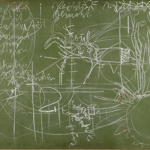by Chris Burn
Scottish National Gallery of Modern Art until 16th October 2016
If you believe it to be true that ‘Art mirrors Life’, then take a look at the work of German artist Joseph Beuys to see just how complicated life has become since the days of Rembrandt and Turner. Consider an offering such as ‘How to Explain Pictures to a Dead Hare’, where the artist (smeared in honey and gold leaf), is seen cradling and talking for two hours to the newly deceased animal as he moves among a display of paintings and drawings; this calls for some pretty heavy thinking on the social and political allusions it contains and indeed some general rumination on the need for showmanship that an artist must have these days, so as to get noticed. For Beuys, this was art that asked questions, conceptual art, before the term had become fashionable.
Beuys, (‘every man is a plastic artist who must determine things for himself’) has been described as both ‘proto-conceptual’ and ‘neo-dadaist’ . He belonged to a group of mid- twentieth century artists (fellow German Kurt Schwitters was another) who found art in the reality of experience, however mundane or indeed unconventional, that might be. He was a participant in the 1960s Fluxus movement which rejected traditional ‘object-focused’ artworks in favour of ‘found’ items, ‘happenings’, and action events which, he sought to show, could be relevant to the social and political ideas of the day.
He was born in Germany in 1920 and was a Hitler Youth member in his teens before joining the Luftwaffe in 1940. Shot down over Russia he later recounted how his life was saved by local Tartars who first coated his body in animal fat and then wrapped him in felt to keep him warm – both these substances recur in his work and have a special significance for him.

The relationship between Beuys and Richard Demarco, well-known Edinburgh artist and art impresario, is well documented in this thought-provoking show. Demarco recognised in Beuys the avant-garde approach that he himself favoured. Between 1970 and Beuys’s death in 1986 the two collaborated in a number of remarkable exhibitions and events, often in Scotland (which Beuys delighted in, calling it ‘the land of Macbeth’). One notable occasion was the Twelve Hour Lecture that Beuys gave at the Edinburgh Festival in 1973 – ‘A Homage to Anacharsis Cloots’ (Cloots was a leading figure in the French Revolution, guillotined in 1794).
Undoubtedly a significant figure in the history of art, Beuys is a relatively little-known figure to the British public. The man who complained that the Berlin Wall was too low ( for aesthetic reasons), is much more famous elsewhere – in Europe and in the USA, where he was a friend of Warhol and instigated several famous happenings. He deserves better recognition here, having been a huge influence on many of today’s big names. Perhaps this exhibition will help.










